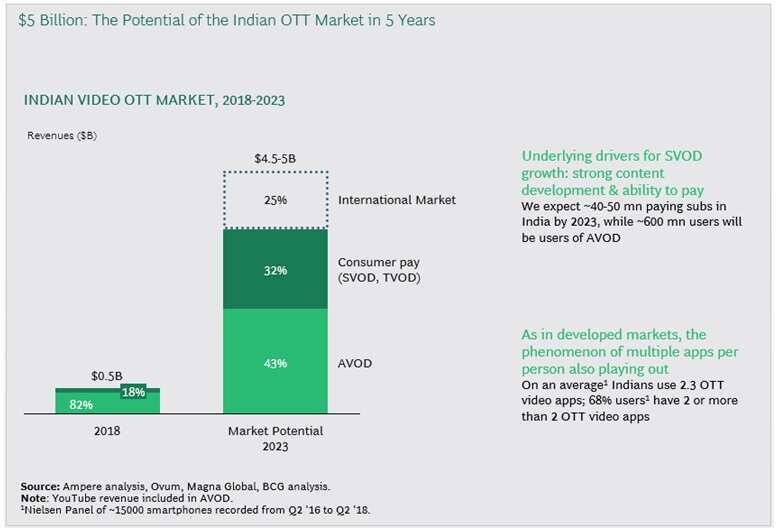Media and Entertainment Industry
The media industry as a whole has a very big umbrella. Entertainment has become a part and parcel of media in recent times making it more viable and convenient for the audience. The growth has promulgated the audience into a new arena and made the customers. The customer-based interventions have put the industry into a new perspective of competition based growth.
The media and entertainment industry in India is one of the fastest-growing industries in the country. Its various segments—film, television, advertising, prints media, music and digital among others—have witnessed tremendous growth in the last few years.
The media and entertainment industry can be broadly divided into the following categories:
- Television
- Radio
- Films
- Digital Media
- OTT
- Social Media
Although in recent times the media and entertainment industry has grown some offshoot branches in the form of Animation, Gaming, Live Events, Music etc. It was a distant past that only television, print and radio. After the coming of the internet and digitalization and with the coming of android based mobile phones, the scenario has changed drastically. The so-called palm-based technology has made the media and entertainment industry more competitive. The introduction of app-based media has also driven the content to be more precise and meaningful. One of the most important parts of the media and entertainment industry is advertising. It is the backbone of all the commercial activities of the media sector. Without advertising, it would be impossible for any medium of media to survive.

Television
The introduction of terrestrial transmission in the form of private TV channels consisting of entertainment and news channels has begun a new era. Before the coming of private TV channels, there was only Doordarshan, as it is controlled and managed by the government. So there was a meaning of competition at that time. After 1992, there were a few channels namely ZEE TV, Sony TV and Star TV. There was very little competition at that time and with the time follows, the no. of channels so is the competition.
As per the industry estimates released by the Broadcast India 2018 Survey conducted by Broadcast Audience Research Council (BARC) India, out of a total of 298 million households in India, around 197 million households have TV sets which are being served by cable TV services, DTH services, HITS services, IPTV services, in addition to a terrestrial TV network of Doordarshan.
Following trends can be seen in the Television in the recent times:
- Content Visibility- The TV channels may not able to catch up with their viewers due to their busy schedules and lifestyle. The TV serials have repeat telecast and it is available on YouTube also.
- Growing No. of Channels- With the introduction of Internet TV, the no. of TV channels has gone up in recent times.
- Constant growth in no. of households having a TV.
- The TV industry is going towards a boom level with the entire stakeholder trying to reach the end viewers.
- Youth viewership has also gone up in recent times.
- The regional genre is also driving both revenue and viewership in the TV industry in India.
The first newspaper was published in Kolkata popularly known as Hickey’s Gazette. The print media industry in India has travelled a long way in India. The print media industry consists of not only newspapers but magazines, books, journals, reports etc. In recent times the print media has gone through a change in terms of both content and presentation. Most Indians start the day with a daily newspaper compared to the western model where people buy newspapers on the daily basis from stands or metro stations.
The Indian print media industry has grown phenomenally over the past few years. Most of the newspapers and magazines are in Hindi and their circulation is also large no. as compared to English publications.
Following trends can be seen in the Print media industry in the recent times:
- The cost of the publications has gone down as compared to the past.
- Rise vernacular press has also risen in recent times. Publications like Eenadu and Malayala Manorama give us ample reasons to believe.
- Local content about political and Socio-cultural issues is being addressed in the publications.
- Advertisement revenue has also gone up in the print media industry, particularly in Hindi and vernacular press.
- Increased literacy rates have also contributed to the rise of print media. Although readers for English publication has gone down a bit in the recent times.
- There is stiff competition from the digital platform. As a result, the publications have started their editions digitally, making it easier for the readers to read.
Radio
In India, the radio was started by All India Radio (AIR) in the 1950s. Because of its reach, the radio has a reach of about 99% in India. The radio industry is a very small part of the broadcasting universe. At Rs. 2,300 crores, the Radio industry comprises about 5% of the broadcasting sector in India. It has a very modest market share which makes it non-viable for its players in the market.
Following trends can be observed in the Radio industry in the recent times:
- FM Radio stations have extended to B-level cities like Agra, Coimbatore etc.
- Because of its access FM has developed as on the go media.
- Radio has become strong in terms of effective ad campaigns with a high recall value and expansive reach.
- The growth of Community Radio helps in addressing local issues and helps in creating awareness.
- New trends have come in the form of RJs turning into celebrities.
- Another interesting trend is that interesting show formats including sports, folk culture, trivia, technicalities of music-making and more, have opened a world of insightful entertainment and have been on the rise.
- Radio has come up as a platform for making music popular.
- Radio extended with the advent of the digital era, radio has expanded its footprint to reach out to its extended target audience.
Films
Films in India have always been a mirror of society. The Indian film industry is the biggest in the world in terms of the production of films. They distract us from our monotonous problems by diverting our attention to the visuals and in the process often extracting emotions or providing relaxation, thereby entertaining us. They also allow social interaction by providing an opportunity to discuss common topics of interest. More often than not we relate to the characters of the movie, thus creating a sense of connection and sometimes even reinforcing our values. Movies intensify some aspects of life such as comedy, romance, war etc. It plays the role of the magnifying glass and it is a platform to quench curiosity about a serious subject.
Following trends can be witnessed in the coming times in India’s film industry:
- Movies with more realistic themes are made to capture the audience’s attention.
- India’s film industry in the coming times will not depend on theatrical releases, films soon will get the same or a large number of audiences on OTT platforms as well.
- The risk of the film being at a financial loss will also be minimized with other means of release like OTT available.
- The film industry has become an organized sector with the introduction of the Producer’s Guild, Cine Artist Association and other associations of workers like light men, spot boys etc.
- The opening of multi-screen theatres also paved the way for the business to grow.
- Online booking through apps also helps in the growth of the film industry in India.
Digital Media
The digital media industry in India has become the most important platform. There is a big debate in the initial stages between electronic and print media and who owns it. Electronic media says that it is seen on a screen so it belongs to them. On the other hand, print media believes that the content is in print form so it will be in print media. Then in the 2000s, there was the starting of content showing on the computer. Does the question arise what is digital media?
Digital media is digitized content that can be transmitted over the internet or computer networks. This can include text, audio, video, and graphics. This means that news from a TV network, newspaper, magazine, etc. that is presented on a Web site or blog can fall into this category. We should also know what constitutes digital media.
There are 3 types of digital media:
Owned Media: Any online asset that you control like your website or social media channels.
Paid Media: Promoting your online content to improve traffic to your owned media assets.
Earned Media: Customer’s recommendation by word of mouth or through social media4.
The following trends can be seen in the digital media industry in India:
- There will be a considerable rise in mobile streaming.
- New demographic content has also come up in the form of vernacular media.
- There has been a shift from consumer to creator. Instagram and Facebook have given rise to this shift.
- Due to the availability of low-cost internet, the users of digital media have risen to manifolds.
- The flip side of the digital revolution is increased piracy.
OTT (Over The Top)
OTT or in full Over The Top media. Over the top (OTT) refers to film and television content provided via a high-speed Internet connection rather than a cable or satellite provider. It is a bit newer media which is fast becoming the rage, especially among youngsters. OTT content can be accessed directly on a computer, but it is often watched on a Web-enabled television or through an Internet-enabled device. OTT content can be accessed directly on a computer, but it is often watched on a Web-enabled television or through an Internet-enabled device.
Netflix and Amazon Prime are OTT platforms that have gained prominence in recent times. Nowadays there are newer apps like ZEE5, SONY LIV, MX Player, HOTSTAR, VOOT, HUNGAMA, EROS NOW etc.
Following trends can be seen recently in OTT:
- Subscription-based users have risen many times since its inception.
- Films nowadays are released only on the OTT.
- While only TV and movies were the two mediums artists could enter, digital content has opened opportunities.
- The next stage of the OTT revolution is a battle to gain supremacy over the Indian market by foreign players.
Social Media
One of the most important contributions of technology in the media sector is social media. Social media is one sphere which has changed the dynamics of how we see media and communication. It has amalgamated all the things on one single platform. The introduction of android based mobile has revolutionized social media. It gives users endless opportunities to express themselves.
With the ease of internet access, the number of active social media users in India stood at 330 million in 2019 and it is expected to reach 448 million by 2023.
The entry of WhatsApp into India’s digital market boosted app usage, with a doubling in rural areas in recent years. Data shows that the reach of the messaging service extends wider than just urban areas. Other popular apps include TikTok and Instagram.
The social video app TikTok has been a huge hit in India, it has reached 1.5 billion downloads worldwide on the App Store as well as Google Play and India leads the chart with 466.8 million or about 31% of all unique installs. Prominent social media apps include Twitter, Watsapp, Facebook, Instagram, Tinder, Helo etc.
Smartphones are increasingly becoming the primary screen for Indian customers, which means, the smartphone and its applications become the principal source of news for about 35% of the country’s internet users, a majority of whom use one or more social networks.
Rural India has 264 million internet users and this is expected to reach 304 million in 2020. Rural India has a sizable portion that is devoid of internet access. Thus, there is immense headroom for growth which will contribute to an increase in the overall internet population over the next few years.
Following trends can be observed in the social media:
- Brands re-evaluating the metrics that matter most.
- More advanced dynamic and direct ads in social media.
- Use of artificial intelligence.
- App-based on total privacy and security.
- Social media will be a new platform for subject-specific ads.
- News based content is the new entrant on social media
Way Forward
The presence of modern communication technologies has made the world a global village where anybody can have access to anything, anywhere. We are ushering into a new era of global communication. We can fight and create awareness of diseases like HIV/AIDS or in recent times Corona Pandemic. The epic rise in the proportion of media especially the new media and social media has created a lot of opportunities to interact. The media and entertainment industry is riding a horse which is galloping with a whirling speed. More innovations will make the media and entertainment industry in India more competitive and will also create job opportunities
Dr Syed Fahar Ali,
HoD & Associate Professor, School of Journalism & Mass Communication, Noida International University, Greater Noida



